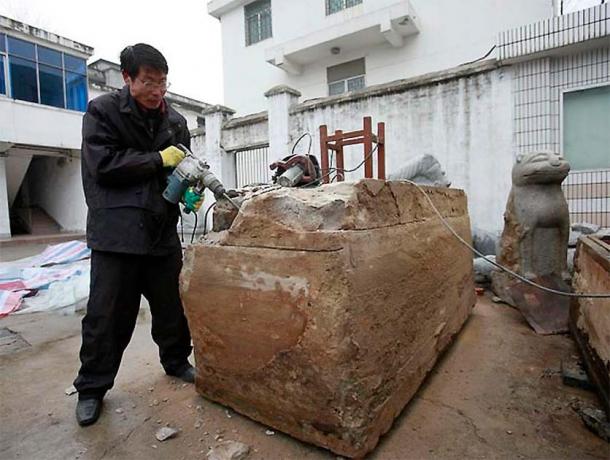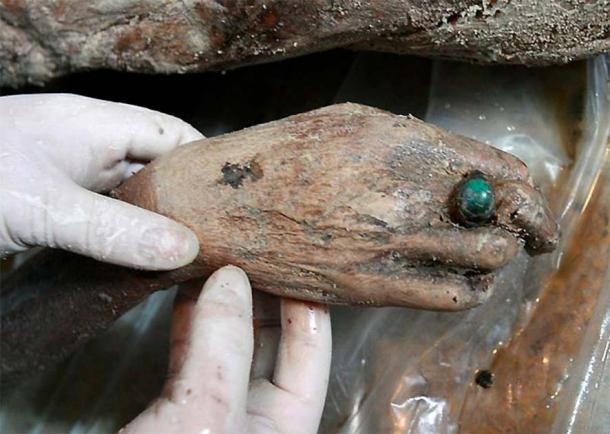Mummies often evoke thoughts of the ancient Egyptians and their sophisticated mummification rituals. These practices aimed to create a seamless transition between life and death and led to remarkable body preservation that is renowned to this day. While most mummies discovered today are a product of this complex process, natural mummification has occurred in rare instances. The Taizhou mummy is an extraordinary example of this, distinguished by its exceptional state of preservation and enigmatic backstory.

Road workers unexpectedly discovered the tomb of a woman, now known as the Taizhou mummy, who was buried during the time of the Ming Dynasty in China. (GU XIANGZHONG, XINHUA)
Taizhou Mummy Unearthed During Routine Road Works in Eastern China
Chinese road workers stumbled upon an astonishing find in 2011 – the remarkably intact remains of a woman from the Ming Dynasty, dating back 700 years. The discovery shed light on the daily life of the people of that era, while also raising questions about the woman’s identity and the secret behind her remarkable preservation. Who was she? And how did her body remain so well-preserved over the centuries?
The discovery of the Taizhou mummy was quite shocking. Road workers in Taizhou, located in eastern China’s Jiangsu Province, were tasked with widening a road. During the excavation process, they dug several feet into the ground and unexpectedly hit a large, solid object about six feet below the surface.
Recognizing the potential significance of their discovery, the workers promptly contacted a team of archaeologists from the Taizhou Museum to excavate the area. Subsequent investigations revealed that the object found in Taizhou was, in fact, a Chinese tomb, containing a three-layered coffin within its walls.

The Taizhou mummy was discovered immersed in a mysterious brown liquid. (GU XIANGZHONG, XINHUA)
Mysterious Brown Liquid: The Enigmatic Preservation of the Taizhou Mummy
As the archaeologists opened the main coffin, they were greeted by layers of silk and linens, all covered in a mysterious brown liquid. Upon further inspection, they uncovered the astonishingly well-preserved remains of a woman, complete with her body, hair, skin, clothing, and jewelry. Even her eyebrows and eyelashes were impeccably preserved, revealing remarkable details about her appearance from centuries ago. Since the discovery, she has come to be known as the Taizhou mummy or the accidental mummy.
Researchers have been unable to definitively determine the age of the woman’s body. However, based on the artifacts and clothing found with the Taizhou mummy, it is believed that she lived during the Ming Dynasty, which spanned from 1368 through 1644. This means that the woman’s body could potentially be up to 700 years old.

The hand of the Ming Dynasty Taizhou mummy, wearing a striking green ring. (GU XIANGZHONG, XINHUA)
The woman was found dressed in traditional clothing from the Ming Dynasty and adorned with several pieces of jewelry, including a striking green ring. Based on the quality of her jewelry and the fine silks she was wrapped in, it is believed that she was a high-ranking civilian. The discovery of her well-preserved remains has provided valuable insights into the daily life and social hierarchy of the Ming Dynasty.
In addition to the stunningly preserved remains of the woman, the coffin also contained bones, ceramics, ancient writings and other relics. The archaeologists who excavated the coffin were unable to determine whether the mysterious brown liquid inside the coffin was used intentionally to preserve the body or if it was simply groundwater that had seeped in over time.
Some researchers, however, have suggested that the woman’s body may have been preserved due to the specific environment in which she was buried. If the temperature and oxygen levels in the water surrounding her were just right, bacteria would have been unable to grow, effectively slowing or halting the process of decomposition. This unexpected discovery left archaeologists and scientists alike eager to learn more about the unique circumstances that led to the Taizhou mummy’s remarkable preservation.
The Taizhou Mummy Raises More Questions Than Answers
This discovery provides researchers with an intimate look into the customs of the Ming Dynasty. They have a very clear view of the clothing and jewelry people wore, and some of the relics that were used during the time. This can answer many questions about the lifestyle, traditions, and daily activities of the people from that time.
The discovery of the Taizhou mummy raised numerous questions about the circumstances that led to the exceptional preservation of her body for centuries. Archaeologists are still trying to determine the identity and social status of the woman, as well as the cause of her death and whether her preservation was intentional.
Unfortunately, the secluded location of the discovery and the absence of additional remains may make it difficult to find definitive answers. However, if similar discoveries are made in the future, they may provide the information needed to answer these, and other questions about the so-called accidental mummy.
Top image: The Taizhou mummy was discovered accidentally by road workers and was found immersed in a mysterious brown liquid. Source: GU XIANGZHONG, XINHUA





